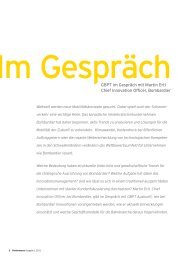PERF RMANCE 04 - The Performance Portal - Ernst & Young
PERF RMANCE 04 - The Performance Portal - Ernst & Young
PERF RMANCE 04 - The Performance Portal - Ernst & Young
Create successful ePaper yourself
Turn your PDF publications into a flip-book with our unique Google optimized e-Paper software.
digital watches and other portable display<br />
applications before being considered for<br />
notebook and desktop computer monitors.<br />
Yet today, the demand for LCD monitors<br />
outstrips the demand for CRT monitors.<br />
Hence, the incumbent technology can<br />
be taken by surprise as the competitive<br />
technology improves at a faster rate than<br />
the incumbent technology and enters<br />
new markets.<br />
<strong>The</strong> three critical issues for managers to<br />
keep in mind are that a) new dimensions<br />
are constantly emerging, b) their<br />
importance is in a state of constant<br />
flux, and c) this state is driven primarily<br />
by technological evolution not innate<br />
consumer tastes. To understand the nature<br />
of competition on these dimensions,<br />
managers need to analyze the range of<br />
current and potential platforms, on current<br />
and emerging dimensions, over time,<br />
along the lines shown in Figure 1. <strong>The</strong>y<br />
also need to monitor related markets<br />
that use the new technologies to identify<br />
progress and opportunities posed by the<br />
new technologies.<br />
Which technology should a<br />
company back?<br />
This discussion brings us back to the<br />
key question that managers face. Which<br />
technology to back? In GM’s case, it turned<br />
out to be a billion-dollar question. How can<br />
our framework help managers to identify<br />
the most promising technology to back? We<br />
argue that the multidimensional analysis of<br />
multi-technology dynamics provides a rich<br />
and insightful picture of a firm’s options.<br />
An example of how to use the<br />
new framework<br />
Let’s consider the automobile battery<br />
market shown in Figure 6. In this<br />
market, we can identify three platform<br />
technologies: galvanic cells, fuel cells<br />
and flow cells. An important dimension<br />
to evaluate the choice of a technology<br />
is its effectiveness in miles per kilowatt.<br />
Figure 6a shows the evolution of these<br />
Figure 6. An example of using the new framework<br />
technologies on this dimension. Within<br />
each of these platform technologies, there<br />
are numerous design and component<br />
technologies that were commercialized<br />
in the auto-battery market. For example,<br />
within galvanic cells, lead-acid, nickelmetal-hydride<br />
(NiMH) and lithium-ion<br />
technologies are all alternate component<br />
technologies. Similarly, the proton<br />
exchange membrane fuel cell (PEMFC)<br />
and zinc-air are alternate component<br />
technologies based on fuel cell and flow cell<br />
platforms respectively.<br />
Zinc-air was better in performance<br />
prior to 2005 and the other technologies<br />
had comparable performance to each<br />
other. Lithium-ion began showing a<br />
sharp increase in effectiveness soon after<br />
its introduction in 1997 (see Figure 6b).<br />
By 1999, lithium-ion crossed fuels cells<br />
and NiMH. In 2006, it crossed lead-acid<br />
and zinc-air as well. It has stayed on top<br />
ever since.<br />
6a. Evolution of platform innovations in the auto-battery market<br />
Efficiency (miles/kW)<br />
Year<br />
Flow cell<br />
Galvanic cell<br />
Fuel cell






